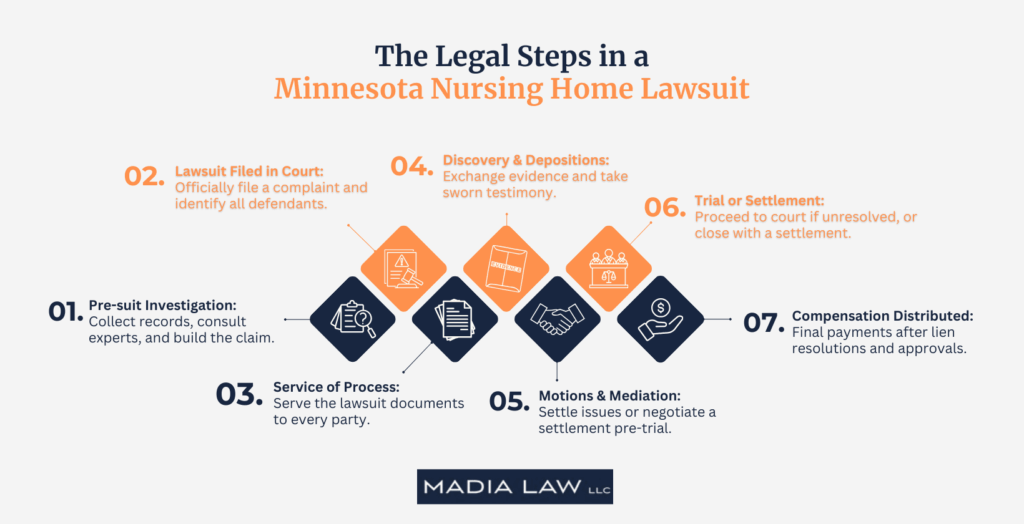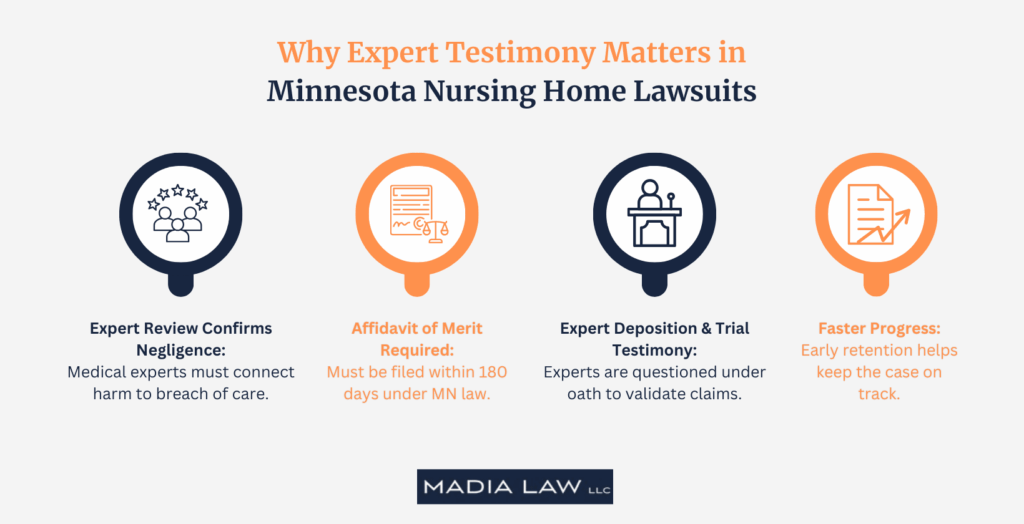
Most nursing home abuse lawsuits in Minnesota take 12 to 24 months to resolve. Some cases settle in just a few months, especially when medical records are clear and the facility cooperates. But if the case involves serious injuries, multiple defendants, or goes to trial, it can take two years or more.
The timeline depends on several moving parts: how quickly evidence is gathered, whether the nursing home delays, and how fast the court can schedule hearings. While it’s possible to settle in under a year, most families should prepare for a longer process.
At Madia Law LLC, we know delay tactics hurt families. That’s why we move fast from day one, preserving evidence, filing claims, and applying pressure. With the right legal team, you can shorten the wait and protect your loved one’s rights.
Typical Timeline for Nursing Home Lawsuits in Minnesota
While most nursing home lawsuits in Minnesota take 12 to 24 months, the real driver behind the timeline is the legal process itself. Each phase: investigation, filing, discovery, and resolution, moves at its own speed, depending on how facts develop, how defendants respond, and how the court assigns dates.
Early Case Assessment & Pre‑Suit Investigation (Timeframe)
The process starts with gathering records, interviewing witnesses, and consulting medical experts. This phase typically lasts 30 to 90 days, depending on how quickly the facility releases documents and whether initial facts clearly point to neglect or abuse. Early cooperation, or resistance, can set the pace for the entire case.
Filing & Service of Process Timeline
Once the claim is prepared, the lawsuit is filed and served on all defendants. In Minnesota, formal service must comply with strict deadlines, and delays often occur if a corporate chain owns the nursing home or is difficult to locate. This phase usually takes 2 to 4 weeks, but may stretch longer with evasive defendants.
Discovery and Depositions: How Long It Takes
Discovery is typically the longest phase of a nursing home lawsuit in Minnesota, often lasting 6 to 9 months. Both sides exchange evidence through formal methods like written interrogatories, medical record requests, and sworn depositions of staff, administrators, or family members.
Experts also submit opinions and may be deposed as well. The pace of discovery is shaped by case complexity, the number of parties involved, and how cooperative each side is.
Pre‑Trial Motions, Mediation, and Settlement Negotiations
After discovery, most cases enter a phase where the court may hear pre-trial motions, and both sides may attempt resolution through mediation or direct settlement talks. Motions address legal disputes that could limit evidence or shape the trial. Mediation involves a neutral party facilitating compromise. Many nursing home cases settle here, often saving months or even a full year compared to going to trial.
For a legal consultation, call 612-349-2729
Key Factors That Can Lengthen or Shorten a Nursing Home Lawsuit
The pace of a nursing home abuse lawsuit in Minnesota depends on several legal, procedural, and external factors. While some issues can be controlled, like early expert retention or proper filing, others, such as court congestion or corporate stall tactics, are harder to avoid. Understanding these elements can help you act quickly where it matters.
Case Complexity and Number of Defendants
The more severe or layered the case, the longer it tends to take. Lawsuits involving multiple injuries, wrongful death, or system-wide care failures require deeper investigation and expert analysis.
Timelines also stretch when more than one party is named. This may include:
- Individual caregivers and nurses
- Nursing home administrators
- Corporate owners or management firms
Each defendant must be served separately, represented by their own legal team, and involved in depositions and evidence exchange. Coordinating across multiple parties often introduces delays at every stage.
Expert Witness Availability and Affidavit Deadlines
In Minnesota, your legal team must submit an affidavit of merit from a qualified expert within 180 days of filing. But legal compliance isn’t the only concern; strategic use of expert timing also matters.
Delays often occur when:
- Experts are booked out months in advance
- Records take too long to review
- Affidavits aren’t prioritized early in the process
Fast expert involvement accelerates both litigation readiness and settlement pressure.
Insurance Company Responses and Tactics
Nursing home insurers often engage in slow-play strategies designed to wear down plaintiffs.
Common tactics include:
- Withholding or delaying record production
- Offering lowball settlements to stall progress
- Filing motions to pause or complicate discovery
- Requesting deadline extensions without a valid reason
- Refusing to negotiate seriously until the trial is near
These delays can add months unless countered by persistent legal action.
Minnesota State & Local Court Scheduling / Judicial Calendars
Minnesota civil courts, especially in Hennepin and Ramsey County, face significant backlogs. Trial calendars fill fast, and even routine hearings may be delayed due to volume and limited courtroom availability.
Once discovery is complete, the trial date may still be 3 to 6 months out, depending on judicial schedules. These systemic delays affect all cases, regardless of merit or readiness.
Statute of Limitations in Minnesota & Its Impact on Timing
In Minnesota, the deadline to file a nursing home abuse or neglect lawsuit depends on the nature of the claim:
- Most medical-related claims must be filed within four years under Minn. Stat. § 541.076.
- Wrongful death claims often carry a two-year statute of limitations.
- Negligence claims unrelated to medical care may follow different deadlines depending on the facts.
These deadlines are strict. If your case is filed late—even by one day—it can be dismissed regardless of how strong the evidence is.
Early legal action gives your attorney time to:
- Secure medical and facility records before they disappear
- Consult with qualified experts
- File the affidavit of merit within statutory deadlines
- Avoid procedural missteps that can invalidate the claim
Families should never assume they have plenty of time. Starting early protects your right to hold the facility accountable and improves the chances of a successful outcome.
Click to contact our personal injury lawyers today
Evidence That Can Speed Up a Nursing Home Lawsuit
When your evidence is clear, organized, and presented early, the defense has fewer tools to delay the case. Strong documentation, credible witnesses, and expert reports increase settlement pressure and reduce the need for prolonged discovery or trial.
Strong Medical Records & Documentation
Accurate and well-structured medical records, including injury reports, treatment logs, and medication charts, are often the foundation of a strong nursing home abuse claim.
When those records clearly indicate lapses in care or inconsistent treatment, it allows:
- Faster expert review
- Less pushback from the defense
- Earlier resolution in mediation or settlement
Eyewitness / Staff / Witness Statements
First-hand accounts from family members, other residents, or facility staff provide narrative context that written records may lack.
Early statements help:
- Clarify timelines and sequences of events
- Corroborate documented injuries
- Prevent disputes over how or when abuse occurred
These testimonies increase credibility and often accelerate settlement discussions.
Expert Reports & Affidavits Prepared Timely
Beyond meeting Minnesota’s legal deadline, early expert reports carry strategic weight. When an expert provides a well-supported opinion soon after case filing, it:
- Signals readiness to litigate
- Increases pressure to resolve early
- Reduces the chance of discovery disputes
Timely affidavits and reports can significantly reduce total case duration.
Proof of Facility Policies / Prior Incidents
Showing a pattern of past neglect or state-cited violations can fast-track accountability.
This includes:
- Failed Department of Health inspections
- Repeated injury reports in the same facility
- Staffing shortages or licensing issues
Pattern evidence strengthens your position and narrows the defense’s ability to argue the incident was isolated or unforeseeable.
Complete a Case Evaluation form now
Timeline for Resolution and Compensation in Minnesota Nursing Home Lawsuits
Reaching a resolution, whether through settlement or trial, doesn’t mean compensation is immediate. Post-resolution steps like lien negotiations, court approvals, and fund disbursement can add weeks to the process. The outcome path (settlement, verdict, or appeal) plays a major role in determining how long payment takes.
Settlements vs Verdicts: What Speeds Things Up
Most Minnesota nursing home lawsuits are resolved through settlement, not trial. When both sides reach an agreement, the timeline often shortens significantly, sometimes by several months to a year. Settlements avoid courtroom scheduling, expert testimony, and jury deliberation.
A trial, on the other hand, typically extends the timeline due to:
- Final pre-trial motions
- Trial preparation and strategy meetings
- Multi-day hearings and witness scheduling
- Jury selection, deliberation, and possible appeals
While trials may offer higher compensation in rare cases, they take longer and carry more risk.
After Settlement: How Long Until You Get Paid?
Even after a case settles, you won’t receive a check immediately. Final steps that must occur include:
- Lien resolution with insurance providers, Medicare, or Medicaid
- Court approval, especially in wrongful death or probate-involved cases
- Fund distribution planning between legal fees, medical reimbursements, and remaining damages
This post-settlement phase usually takes 4 to 12 weeks, depending on the complexity of the liens and administrative approvals involved.
What Happens If the Case Goes to Trial vs. Appeal
If a verdict is issued and the losing party appeals, the case enters a new phase entirely. Appeals in Minnesota can add 6 to 12 months or more to the timeline.
Key impacts of an appeal include:
- Delayed compensation, even if you win
- Possible retrial if the appellate court reverses
- Additional legal fees and case monitoring
Not all cases are appealed, but when they are, the entire timeline resets around a new court schedule.
Mistakes That Delay Nursing Home Lawsuits
Certain avoidable errors can stall or even jeopardize a nursing home abuse lawsuit in Minnesota. Being aware of these risks early helps keep your case on track.
- Waiting too long to contact an attorney can lead to missed deadlines, rushed filings, or the complete loss of your right to file.
- Failing to organize medical records and facility documents delays expert review and weakens early settlement leverage.
- Missing the affidavit of merit deadline, which is required within 180 days, can result in the immediate dismissal of the claim.
- Switching attorneys mid-case without coordination often causes communication gaps, duplicate work, or missed court deadlines.
- Ignoring attorney communications or requests leads to unnecessary court extensions, stalled discovery, and trial delays.
Avoiding these common mistakes can save months of lost time and significantly improve your chances of reaching a timely resolution.
Insights from Madia Law LLC on Nursing Home Lawsuit Timelines
At Madia Law LLC, we’ve seen how timelines for nursing home abuse cases in Minnesota can shift dramatically based on just a few key factors: early access to records, cooperation from the facility, and the speed at which both sides engage in the legal process.
Delays are often caused by avoidable factors, such as slow responses, incomplete documentation, or strategic stalling by the defense. But when evidence is strong and the legal team acts quickly, resolution can come faster, and with better outcomes.
Every case moves at its own pace, but early legal action always creates a massive advantage for you.
Frequently Asked Questions About Minnesota Nursing Home Lawsuits
How Soon Should I Contact a Lawyer After Suspecting Nursing Home Abuse?
You should contact a lawyer as soon as you suspect nursing home abuse. Early action in a Minnesota case helps preserve evidence, meet deadlines, and strengthen your nursing home lawsuit timeline.
Do Photos or Videos Help Prove Nursing Home Abuse?
Yes, photos or videos help prove nursing home abuse. Visual evidence in Minnesota neglect lawsuits supports witness statements, medical records, and timelines, making it harder for defendants to dispute what happened.
What if Expert Affidavits Are Not Filed on Time in Minnesota?
If expert affidavits are not filed on time in Minnesota, a nursing home lawsuit can be dismissed. The affidavit deadline is mandatory, and missing it often results in the claim being dismissed regardless of its merit.
Can I Still File if I Miss the Statute of Limitations Deadline in Minnesota?
No, you cannot file if you miss the statute of limitations deadline in Minnesota. Nursing home abuse lawsuits must meet strict time limits; late claims are barred, even with strong evidence.
How Common Are Nursing Home Trial Verdicts in Minnesota?
Nursing home trial verdicts in Minnesota are uncommon. Most cases settle before trial, as settlements provide quicker resolution compared to jury verdicts, which require longer timelines and carry a higher risk.
Can the Timeline for a Nursing Home Lawsuit in Minnesota Be Shorter Than Average? Under What Circumstances?
Yes, the timeline for a nursing home lawsuit in Minnesota can be shorter if liability is clear, records are complete, and both parties cooperate in early settlement or mediation.
Why Do Nursing Home Settlement Payments Get Delayed?
Nursing home settlement payments get delayed due to lien negotiations, court approvals, or insurer processing. In Minnesota, payment is usually disbursed within 4-12 weeks after the final settlement is signed.
If You’re Considering a Nursing Home Lawsuit in Minnesota, What’s Next?
By now, you know that nursing home lawsuits involve many moving parts, and no two timelines are identical. But if you’re here, it’s likely because something went wrong, and you’re wondering what to do next.
Start by gathering anything you already have: care notes, photos, text messages, voicemails, or records. Even a few pieces of early documentation can give your legal team a head start. From there, a focused legal strategy can determine if early settlement is realistic or if trial is the better path.
Understanding timelines is helpful, but taking the next step is what moves a case forward. If you’re unsure where to begin, we’re here to help you find clarity, quickly and confidently.
Call (612) 349-2729 |
Submit Your Case Online
Located in Minneapolis, serving all of Minnesota
Call 612-349-2729 or complete a Case Evaluation form




